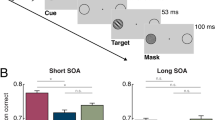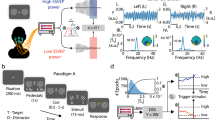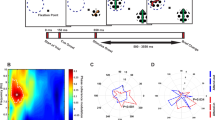Abstract
Adaptive behavior requires the rapid switching of attention among potentially relevant stimuli that appear in the environment. The present study used an electrophysiological approach to continuously measure the time course of visual pathway facilitation in human subjects as attention was shifted from one location to another. Steady-state visual evoked potentials (SSVEPs) were recorded to rapidly flickering lights at attended and unattended locations, and variations in SSVEP amplitude over time were calculated after a cue to shift attention. The build-up of cortical facilitation reflected in SSVEP amplitude was found to bear a close temporal relationship with the emergence of accurate target discriminations at the newly attended location.
This is a preview of subscription content, access via your institution
Access options
Subscribe to this journal
Receive 12 print issues and online access
$209.00 per year
only $17.42 per issue
Buy this article
- Purchase on Springer Link
- Instant access to full article PDF
Prices may be subject to local taxes which are calculated during checkout




Similar content being viewed by others
References
Posner, M. I., Inhoff, A. W., Friedrich, F. J. & Cohen, A. Isolating attentional systems: a cognitive-anatomical analysis. Psychobiology 15, 107–121 (1987).
Treisman, A. Features and objects: the fourteenth Bartlett memorial lecture. Q. J. Exp. Psychol. 40, 201–237 (1988).
Posner, M. I., Snyder, C. R. R. & Davidson, B. J. Attention and the detection of signals. J. Exp. Psychol. 109, 160–174 (1980).
Eriksen, C. W. & St. James, J. D. Visual attention within and around the field of focal attention: a zoom lens model. Percept. Psychophys. 40, 225–240 (1986).
LaBerge, D. Attentional Processing: The Brain's Art of Mindfulness (Harvard Univ. Press, Cambridge, Massachusetts, 1995).
Luck, S. J., Hillyard, S. A., Mouloua, M. & Hawkins, H. L. Mechanisms of visual-spatial attention: resource allocation or uncertainty reduction . J. Exp. Psychol. Hum. Percept. Perform. 22, 725–737 (1996).
Cheal, M. L., Lyon, D. R. & Gottlob, L. R. A framework for understanding the allocation of attention in location-precued discrimination. Q. J. Exp. Psychol. 47, 699–739 (1994).
Duncan, J., Ward, R. & Shapiro, K. Direct measurement of attentional dwell time in human vision. Nature 369, 313– 315 (1994).
Sperling, G., Budiansky, J., Spivak, J. R. & Johnson, M. C. Extremely rapid visual search: the maximum rate of scanning letters for the presence of a numeral. Science 174, 307– 311 (1971).
Stelmach, L. B., Campsall, J. M. & Herdman, C. M. Attentional and ocular movements. J. Exp. Psychol. Hum. Percept. Perform. 23, 823– 844 (1997).
Shapiro, K., Driver, J., Ward, R. & Sorensen, R. E. Priming from the attentional blink: A failure to extract visual tokens but not visual types. Psychol. Sci. 8, 95–100 (1997).
Shapiro, K. L., Arnell, K. M. & Raymond, J. E. The attentional blink. Trends Cog. Sci. 1, 291–296 ( 1997).
Ward, R., Duncan, J. & Shapiro, K. The slow time-course of visual attention. Cog. Psychol. 30, 79–109 (1996).
LaBerge, D., Carlson, R. L., Williams, J. K. & Bunney, B. G. Shifting attention in visual space: Tests of moving-spotlight models versus an activity-distribution model. J. Exp. Psychol. Hum. Percept. Perform. 23,1380–1392 ( 1997).
Reeves, A. & Sperling, G. Attention gating in short-term visual memory. Psychol. Rev. 93,180– 206 (1986).
Luck, S. J., Chellazzi, L., Hillyard, S. A. & Desimone, R. Neural mechanisms of spatial selective attention in areas V1, V2, and V4 of macaque visual cortex. J. Neurophysiol. 77, 24–42 (1997).
Motter, B. C. Neural correlates of feature selective memory and pop-out in extrastriate area V4. J. Neurosci. 14, 2190– 2199 (1994).
Motter, B. C. in The Attentive Brain (ed. Parasuraman, R.) 51– 69 (MIT Press, Cambridge, Massachusetts, 1998).
Hillyard, S. A. & Anllo-Vento, L. Event-related brain potentials in the study of visual selective attention. Proc. Natl. Acad. Sci. USA 95, 781–787 (1998).
Mangun, G. R. Neural mechanisms of visual selective attention. Psychophysiology 32, 4–18 (1995 ).
Hillyard, S. A., Vogel, E. K. & Luck, S. J. Sensory gain control (amplification) as a mechanism of selective attention: electrophysiological and neuroimaging evidence. Phil. Trans. R. Soc. Lond. B Biol. Sci. (in press).
Hillyard, S. A. et al. Combining steady-state visual evoked potentials and fMRI to localize brain activity during selective attention. Hum. Brain Mapp. 5, 287–292 ( 1997).
Morgan, S. T., Hansen, J. C. & Hillyard, S. A. Selective attention to stimulus location modulates the steady state visual evoked potential. Proc. Natl. Acad. Sci. USA 93, 4770–4774 ( 1996).
Müller, M. M. et al. Effects of spatial selective attention on the steady-state visual evoked potential in the 20–28 Hz range. Cog. Brain Res. 6, 249–261 ( 1998).
Regan, D. in Human Brain Electrophysiology: Evoked Potentials and Evoked Magnetic Fields in Science and Medicine 70–112 (Elsevier, New York, 1989).
Corbetta, M. Frontoparietal cortical networks for directing attention and the eye to visual locations: Identical, independent, or overlapping neural systems? Proc. Natl. Acad. Sci. USA 95, 831– 838 (1998).
Luck, S. J., Vogel, E. K. & Shapiro, K. L. Word meanings can be accessed but not reported during the attentional blink. Nature 383, 616– 618 (1996).
Yamaguchi, S., Tsuchiya, H. & Kobayashi, S. Electroencephalographic activity associated with shifts of visuospatial attention. Brain 117, 553 –562 (1994).
Clark, V. P., Fan, S. & Hillyard, S. A. Identification of early visual evoked potential generators by retinotopic and topographic analyses. Hum. Brain Mapp. 2, 170–187 (1995).
Acknowledgements
We thank Jon Hansen, Lourdes Anllo-Vento, Matt Marlow and Carlos Nava for technical advice and support. The work was supported by grants from ONR (N00014-93-I-0942), NIMH (MH-25594), NIH (NS 17778) and the Deutsche Forschungsgemeinschaft.
Author information
Authors and Affiliations
Corresponding author
Rights and permissions
About this article
Cite this article
Müller, M., Teder-Sälejärvi, W. & Hillyard, S. The time course of cortical facilitation during cued shifts of spatial attention. Nat Neurosci 1, 631–634 (1998). https://doi.org/10.1038/2865
Received:
Accepted:
Issue Date:
DOI: https://doi.org/10.1038/2865
This article is cited by
-
A gaze bias in the mind’s eye
Nature Human Behaviour (2019)
-
Human gaze tracks attentional focusing in memorized visual space
Nature Human Behaviour (2019)
-
Attentional fluctuations induce shared variability in macaque primary visual cortex
Nature Communications (2018)
-
Exploring the temporal dynamics of sustained and transient spatial attention using steady-state visual evoked potentials
Experimental Brain Research (2017)
-
Visual attention spreads broadly but selects information locally
Scientific Reports (2016)



